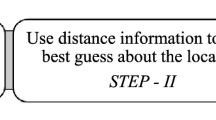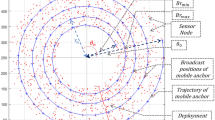Abstract
This paper proposes a progressive Isomap algorithm for node localization. The algorithm is an extension of centralized Isomap and is capable of effectively localizing new nodes progressively, without neglecting preceding computational results. In the initial startup phase, sensor nodes within two hop range of three non-collinear anchor nodes are localized using range (\(\epsilon\))-Isomap. Afterwards, in the progressive phase, the remaining nodes are localized in a sequential manner, using recently localized nodes. The localization process initiated at different nodes in the network give rise to the overlapping substructures of localized nodes. The overlapped substructures are stitched to form a single coordinate system. Finally, Helmert Transformation is used to obtain the global coordinates of the nodes. The effects of varying various parameters on the accuracy and scalability of the proposed algorithm are studied through the simulation. Results indicate that the proposed algorithm has good positioning accuracy and noise-robustness.









Similar content being viewed by others
References
Mao, G., Fidan, B., & Anderson, B. D. (2007). Localization. In N. P. Mahalik (Ed.), Sensor networks and configuration: Fundamentals, standards, platforms and applications (pp. 281–315). Berlin: Springer. doi:10.1007/3-540-37366-7.
Savvides, A., Han, C. C., & Strivastava, M. B. (2001). Dynamic fine-grained localization in ad-hoc networks of sensors. In Proceedings of the 7th ACM international conference on mobile computing and networking (MOBICOM’01) (pp. 166–179). doi:10.1145/381677.381693.
Chan, H., Luk, M., & Perrig, A. (2005). Using clustering information for sensor network localization. In Proceedings of the 1st IEEE international conference on distributed computing in sensor systems (DCOSS’05) (pp. 109–125). doi:10.1007/11502593_11.
Rashid, H., & Turuk, A. K. (2013). Localization of wireless sensor networks using a single anchor node. Wireless Personal Communications, 72(2), 975–986. doi:10.1007/s11277-013-1050-y.
Zhang, Y., Chen, Y., & Liu, Y. (2012). Towards unique and anchor-free localization for wireless sensor networks. Wireless Personal Communications, 63(1), 261–278. doi:10.1007/s11277-011-0337-0.
Shen, S., Yang, B., Qian, K., & Jiang, X. (2015). An efficient localization algorithm in wireless sensor networks. In Proceedings of the 3rd IEEE international symposium on computing and networking (CANDAR) (pp. 291–294). doi:10.1109/CANDAR.2015.99.
Priyantha, N. B., Balakrishnan, H., Demaine, E., & Teller, S. (2003). Anchor-free distributed localization in sensor networks. In Proceedings of the 1st ACM international conference on embedded networked sensor systems (pp. 340–341). doi:10.1145/958491.958550.
Wang, D., Yang, L., & Cheng, X. (2016). A low-complexity cooperative algorithm for robust localization in wireless sensor networks. In International conference on computing, networking and communications (ICNC) (pp. 1–5). doi:10.1109/ICCNC.2016.7440715.
Schlupkothen, S., Dartmann, G., & Ascheid, G. (2015). A novel low-complexity numerical localization method for dynamic wireless sensor networks. IEEE Transactions on Signal Processing, 63(15), 4102–4114. doi:10.1109/TSP.2015.2422685.
Rabaey, C. S. J., & Langendoen, K. (2002). Robust positioning algorithms for distributed ad-hoc wireless sensor networks. In Proceedings of the general track of the annual conference on USENIX annual technical conference (ATEC ‘02) (pp. 317–327).
Zhang, Y., Wu, W., & Chen, Y. (2005). A range-based localization algorithm for wireless sensor networks. Journal of Communications and Networks, 7(4), 429–437. doi:10.1109/JCN.2005.6387985.
Tomic, S., & Mezei, I. (2016). Improvements of DV-Hop localization algorithm for wireless sensor networks. Telecommunication Systems, 61(1), 93–106. doi:10.1007/s11235-015-0014-9.
He, T., Huang, C., Blum, B. M., Stankovic, J. A., & Abdelzaher, T. (2003). Range-free localization schemes for large scale sensor networks. In Proceedings of the 9th annual international conference on mobile computing and networking (MobiCom’03) (pp. 81–95). doi:10.1145/938985.938995.
Liang, C., & Wen, F. (2016). Received signal strength based robust cooperative localization with dynamic path loss model. IEEE Sensors Journal, 16(5), 1265–1270. doi:10.1109/JSEN.2015.2500270.
Rencheng, J., Hongbin, W., Bo, P., & Ning, G. (2008). Research on RSSI-based localization in wireless sensor networks. In Proceedings of the 4th IEEE international conference on wireless communications, networking and mobile computing (WiCOM’08) (pp. 1–4). doi:10.1109/WiCom.2008.963.
Kalpana, R., & Baskaran, M. (2016). TAR: TOA–AOA based random transmission directed localization. Wireless Personal Communications. doi:10.1007/s11277-016-3237-5.
Niculescu, D., & Nath, B. (2003). Ad hoc positioning system (APS) using AOA. In Proceedings of the 22nd annual joint conference of the ieee computer and communications societies (Vol. 3, pp. 1734–1743).
Xu, B., Sun, G., Yu, R., & Yang, Z. (2013). High-accuracy TDOA-based localization without time synchronization. IEEE Transactions on Parallel and Distributed Systems, 24(8), 1567–1576. doi:10.1109/TPDS.2012.248.
Shang, Y., Ruml, W., Zhang, Y., & Fromherz, M. P. (2003). Localization from mere connectivity. In Proceedings of the 4th ACM international symposium on mobile ad hoc networking & computing (MobiHoc’03) (pp. 201–212). doi:10.1145/778415.778439.
Franceschini, F., Galetto, M., Maisano, D., & Mastrogiacomo, L. (2009). A review of localization algorithms for distributed wireless sensor networks in manufacturing. International Journal of Computer Integrated Manufacturing, 22(7), 698–716. doi:10.1080/09511920601182217.
Gezici, S. (2008). A survey on wireless position estimation. Wireless Personal Communications, 44(3), 263–282. doi:10.1007/s11277-007-9375-z.
Ji, X., & Zha, H. (2004). Sensor positioning in wireless ad-hoc sensor networks using multidimensional scaling. In Proceedings of the 23rd annual joint conference of the IEEE computer and communications societies (INFOCOM’04) (Vol. 4, pp. 2652–2661). doi:10.1109/infcom.2004.1354684.
Patwari, N., & Hero III, A. O. (2004). Manifold learning algorithms for localization in wireless sensor networks. In Proceedings of the IEEE international conference on acoustics, speech, and signal processing (ICASSP’04) (Vol. 3, pp. iii-857). doi:10.1109/ICASSP.2004.1326680.
Shi, L. K., He, P. L., Liu, B., Fu, K., & Wu, Q. (2005). A robust generalization of Isomap for new data. In Proceedings of IEEE international conference on machine learning and cybernetics (ICMLC’05) (Vol. 3, pp. 1707–1712). doi:10.1109/ICMLC.2005.1527219.
Zhang, Z., Wang, J., & Zha, H. (2012). Adaptive manifold learning. IEEE Transactions on Pattern Analysis and Machine Intelligence, 34(2), 253–265. doi:10.1109/TPAMI.2011.115.
Saul, L. K., & Roweis, S. T. (2003). Think globally, fit locally: Unsupervised learning of low dimensional manifolds. The Journal of Machine Learning Research, 4, 119–155. doi:10.1162/153244304322972667.
Jolliffe, I. T. (2002). Principal component analysis. New York: Springer. doi:10.1007/b98835.
Cox, T. F., & Cox, M. A. (Eds.). (2000). Multidimensional scaling (2nd ed.). London/Boca Raton: Chapman & Hall/CRC. doi:10.1201/9781420036121.
Tenenbaum, J. B., De Silva, V., & Langford, J. C. (2000). A global geometric framework for nonlinear dimensionality reduction. Science, 290(5500), 2319–2323. doi:10.1126/science.290.5500.2319.
Roweis, S. T., & Saul, L. K. (2000). Nonlinear dimensionality reduction by locally linear embedding. Science, 290(5500), 2323–2326. doi:10.1126/science.290.5500.2323.
Wang, C., Chen, J., Sun, Y., & Shen, X. S. (2009). Wireless sensor networks localization with Isomap. In Proceedings of the IEEE international conference on communications (ICC’09) (pp. 1–5). doi:10.1109/icc.2009.5199576.
Bengio, Y., Paiement, J. F., Vincent, P., Delalleau, O., Le Roux, N., & Ouimet, M. (2004). Out-of-sample extensions for lle, isomap, mds, eigenmaps, and spectral clustering. Advances in Neural Information Processing Systems, 16, 177–184.
Law, M. H., & Jain, A. K. (2006). Incremental nonlinear dimensionality reduction by manifold learning. IEEE Transactions on Pattern Analysis and Machine Intelligence, 28(3), 377–391. doi:10.1109/TPAMI.2006.56.
Zhao, D., & Yang, L. (2009). Incremental isometric embedding of high-dimensional data using connected neighborhood graphs. IEEE Transactions on Pattern Analysis and Machine Intelligence, 31(1), 86–98. doi:10.1109/TPAMI.2008.34.
Zhang, Y., Wang, Y., Li, C., & Wang, K. (2008). Kernel based incremental learning Isomap algorithm. In IEEE international conference on information and automation (ICIA’08) (pp. 184–189). doi:10.1109/icinfa.2008.4607993.
Mao, G., Fidan, B., & Anderson, B. D. (2007). Wireless sensor network localization techniques. Computer Networks, 51(10), 2529–2553. doi:10.1016/j.comnet.2006.11.018.
Shang, Y., Shi, H., & Ahmed, A. (2004). Performance study of localization methods for ad-hoc sensor networks. In Proceedings of the 1st IEEE international conference on mobile ad hoc and sensor systems (MASS’04) (pp. 184–193). doi:10.1109/MAHSS.2004.1392106.
Li, B., He, Y., Guo, F., & Zuo, L. (2013). A novel localization algorithm based on Isomap and partial least squares for wireless sensor networks. IEEE Transactions on Instrumentation and Measurement, 62(2), 304–314. doi:10.1109/TIM.2012.2216476.
Meertens, L., & Fitzpatrick, S. (2004). The distributed construction of a global coordinate system in a network of static computational nodes from inter-node distances. Kestrel Institute Technical Report KES.U.04.04. Retrieved from https://www.kestrel.edu/home/people/fitzpatrick/pub/KES.U.04.04.pdf.
Horn, B. K. (1987). Closed-form solution of absolute orientation using unit quaternions. JOSA A, 4(4), 629–642. doi:10.1364/JOSAA.4.000629.
Bachrach, J., & Taylor, C. (2005). Localization in sensor networks. In I. Stojmenovic (Ed.), Handbook of sensor networks: Algorithms and architectures (pp. 277–310). New Jersey: Wiley. doi:10.1002/047174414x.ch9.
Alikhani, S., Kunz, T., & St-Hilaire, M. (2010). iCCA-MAP versus MCL and dual MCL: Comparison of mobile node localization algorithms. In Ad-Hoc, mobile and wireless networks (pp. 163–176). Berlin: Springer. doi:10.1007/978-3-642-14785-2_13.
Author information
Authors and Affiliations
Corresponding author
Rights and permissions
About this article
Cite this article
Kashniyal, J., Verma, S. & Singh, K.P. Wireless Sensor Networks Localization Using Progressive Isomap. Wireless Pers Commun 92, 1281–1302 (2017). https://doi.org/10.1007/s11277-016-3606-0
Published:
Issue Date:
DOI: https://doi.org/10.1007/s11277-016-3606-0




